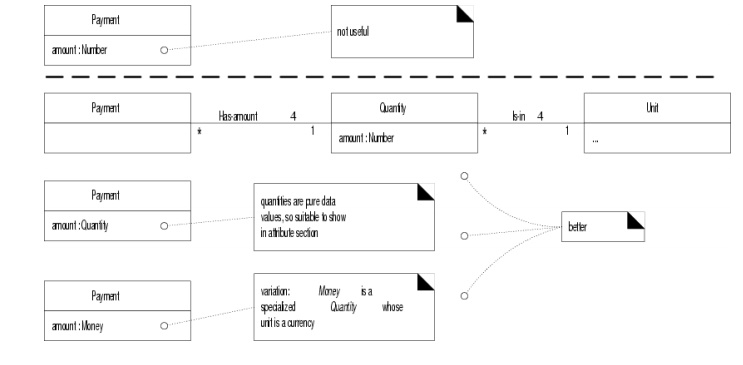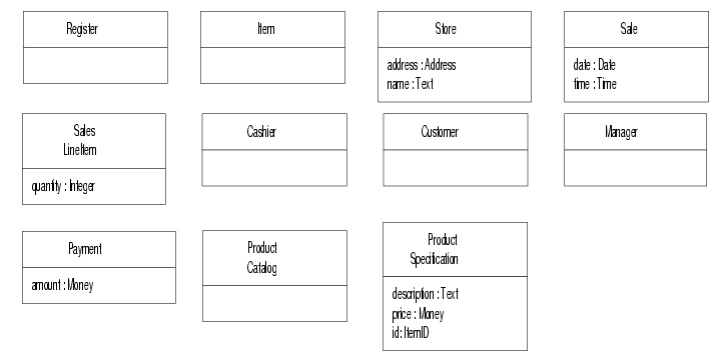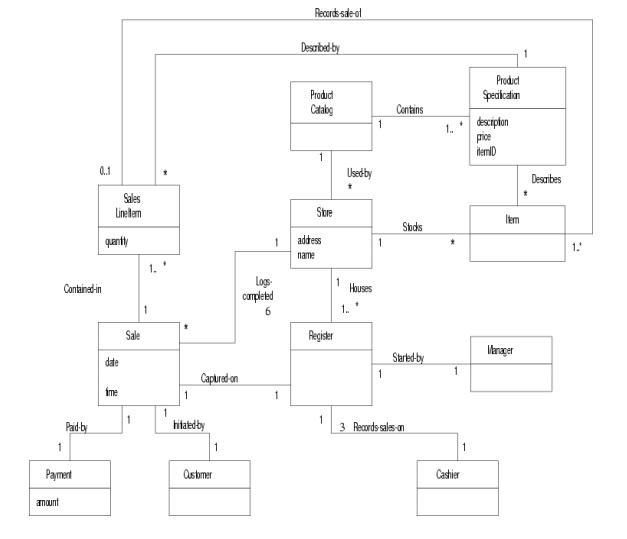Chapter: Software Design
Software Design: Maintenance and Metrics
Maintenance and Metrics
ü During
use case realization, we identify mainly four "types" of classes,
boundary classes, data store classes and control classes.
ü The
entity classes represent the information that the system uses. Examples of
entity classes are: Customer, Product, and Supplier. Entity classes are
essential to the system as the expected functionality of the system includes
maintaining information about them or retrieving information from them.
ü The
boundary classes represent the interaction between the system and its actors. A
GUI form is an example of a boundary class.
ü Data
store classes encapsulate the design decisions about data storage and retrieval
strategies. This provides us flexibility to move a n application from database
platform to another.
ü The
control classes represent the control logic of the system. They implement the
flow of events as given in a use case.
Entity Classes
ü Entity
classes are the abstractions of the keys concepts of the system being modelled.
If the steps of the Architectural Analysis have been carried out, many of the
entity classes may have already been identified during those steps.
ü The Core
functionality and logic of the system are encapsulated in the various entity
classes. For example, if interest is to be calculated and paid to savings
account holders, a savings Account entity class may be responsible for
computing and returning the interest.
ü You can
normally look for the following types of things as potential entity classes:
1. Roles
played by people or organizations about which information is required to be
maintained by the system. For Example, Student in a Library Management System,
Vendor in a Purchase Ordering System.
2. Other physical,
tangible things. For example, Book in a Library Management System.
3. Events
that requires remembrance. For example, Reservation and Issue in a Library
Management System.
ü The
logical data structures (attributes and relationships) of the entity classes
would be designed to hold and manipulate the data according to the system's
requirements. Values of the attributes and their relationships of the entity
class objects are often given by actors. The entity classes are responsible for
storing and managing information in the system.
ü Entity
class objects are usually persistent, having attributes and relationships that
need to be retained for a long time, sometimes even before the life of system.
An entity class is usually not specific to one use cause realization. Objects
of most entity classes would required in multiple use cases. Sometimes, an
entity object may not be specific to the system itself.
Boundary Classes
ü Boundary
classes represent the interaction between the system and its actors. They
insulate the system from changes in the surroundings of the system, such as
user interfaces, and interfaces to other systems.
ü There may
be various types of boundary classes in a system:
1. User
Interfaces classes: Classes for encapsulating the human user interface of the
system, such as GUI forms.
2. System
Interface Classes: Classes that encapsulate the interaction of the system with
other systems.
3. Device
Interface Classes: Classes that provide the interface to devices that detect
external events.
ü An
important objective of identifying boundary classes is to ensure that the
entity classes and the control classes are not affected by any changes to the
boundary classes.
ü Actors
interact with the system only through the boundary classes.
User Interface Classes
A user
interface class represents the interaction between a use case and its
initiating actor. This class has the responsibility of coordinating the
interaction with the actor. A boundary class may have various subsidiary
classes to which some of its responsibilities are delegated. For example, in a
GUI application, there may be multiple forms within a use case.
ü During
use case analysis, you should use the boundary classes as just place-holders
for the GUI forms. Detailed GUI design is an activity of Class Design. During
Analysis, the emphasis should be only on isolating all environment-dependent
behaviour as boundary classes. These classes will get refined or replaced in
the later stages.
System Interface Classes
ü A system
interface class is responsible for interfacing with an external system. The
interface offered by the external system would have been identified by the
developers of that system. Thus, the behaviour of a system interface class
should be derived directly from the interface specifications of the external
system.
ü System
interface classes achieve the purpose of isolating the internal details of the
external systems, which may change over a period of time. Our system should not
get affected by such changes in the internal details of the external systems.
Device Interface Classes
ü Device
interface classes are responsible for interacting with the external devices
that the system may depend upon for receiving inputs or handling outputs.
Examples of such external devices would be: bar code reader, system clock,
printer, etc.
ü A device
may already have a well-defined interface, which could be used by you later
during design. Therefore, a note of such interface should be made in the model
documentation.
Data Store Classes
ü Data
Store classes encapsulate our design decisions about the database structures
which are used to store entity class objects, and to retrieve them later. For
each entity class that required persistence, we create a corresponding data
store class. A data store class typically receives an object of an entity
class, and make it persistence (for example, by inserting a row in a table). At
a later point of time, we may ask the data store class to return the entity
class object.
ü Encapsulating
the database design designs in data store classes, makes the entity classes
independent of the database structure, and thus provides us greater flexibility
to move an application from one database platform to another.
Controller Classes
ü Controller
classes provide co-ordinating behaviour in the system. A typical example would
be a controller class implementing the logic and flow of events of a use case.
ü Controller
Classes isolates the entity classes and boundary classes from each other,
making the system independent of the changes to the system boundary. They also
isolate the use case specific behaviour from the entity class objects, thus
making them re-usable across use cases and even across systems.
ü Simple
use cases may be performed without using controller classes, with direct flow
of data between boundary objects and entity objects. However, more complex use
cases usually require and benefit from such controller classes. The
characteristics of controller classes are:
1. They
define the order of events and transactions within a use case. In other words,
they encapsulate the use case-specific behaviour of the system.
2. They are
relatively independent of the changes to the internal structure or behaviour of
the entity classes.
3. They are
nearly independent of changes to the boundary classes.
4. They may
use or set several entity classes, thus coordinating the behaviour of these
entity classes. However, this coordination can be invisible to the
participating entity classes.
ü Though
most of the times a control class correspond to a single use case, some times a
single controller class may be use to control several use cases. Some tines
there may even be multiple controller classes with in a single use case. As
mentioned earlier, there may be use cases that do not require controller
classes.
Association:
ü Association
defines the relationship between two or more classes in the System. These
generally relates to the one object having instance or reference of another
object inside it. This article discusses on how we can implement Association in
UML.
ü Associations
in UML can be implemented using following ways:
1.Multiplicity
2.Aggregation
3.Composition
Multiplicity in UML: Multiplicity
indicates the no of instance of one class is linked to one instance of another class. The various multiplicity values are
listed below:
Attributes
ü It is a
logical data value of an object
ü In UML:
1. Attributes
are shown in the second compartment of the class box.
2. The type
of an attribute may optionally be shown.

In a
domain model, attributes and data types should be simple. Complex concepts
should be represented by an association to another conceptual class.

ü An
attribute should be what the UML standard calls a data type: a set of values for which unique identity is not
meaningful. Numbers, strings, Booleans, dates, times, phone numbers, and
addresses are examples of data types. Values of these types are called value objects.
Relating Types
ü Conceptual
classes in a domain model should be related by associations, not attributes.
ü In
particular, an attribute should not be used as a kind of foreign key.

Quantities and Units
Quantities
with associated units should be represented either as conceptual classes or as
attributes of specialized types that imply units (e.g., Money or Weight).

Derived Attributes
ü A
quantity that can be calculated from other values, such as role multiplicities,
is a derived attribute, designated
in UML by a leading slash symbol.
NextGen POS Domain Model Attributes


ü Strategies to Identify Conceptual Classes
ü Two
techniques are presented in the following sections:
1. Use a
conceptual class category list.
2. Identify
noun phrases.
ü Another
excellent technique for domain modeling is the use of analysis patterns, which are existing partial domain models created
by experts
Finding Conceptual Classes with
Noun Phrase Identification
ü Another
useful technique (because of its simplicity) suggested in [Abbot83] is
linguistic analysis: identify the nouns and noun phrases in textual descriptions
of a domain, and consider them as candidate conceptual classes or attributes.
ü Care must
be applied with this method; a mechanical noun-to-class mapping isn't possible,
and words in natural languages are ambiguous. Nevertheless, it is another
source of inspiration. The fully dressed use cases are an excellent description
to draw from for this analysis. For example, the current scenario of the Process Sale use case can be used.
Main Success Scenario (or Basic
Flow):
1. Customer arrives at a POS checkout with goods and/or services to purchase.
2. Cashier starts a new sale.
3. Cashier enters item identifier.
4. System
records sale line item and presents item description, price, and running total. Price calculated from a set of
price rules. Cashier repeats steps 2-3 until indicates done.
5. System
presents total with taxes
calculated.
6. Cashier
tells Customer the total, and asks for payment.
7. Customer
pays and System handles payment.
8. System
logs the completed sale and sends
sale and payment information to the external Accounting (for accounting and
commissions) and Inventory systems
(to update inventory).
9. System
presents receipt.
10.
10.Customer leaves with receipt and goods (if any).
Extensions
(or Alternative Flows): 7a. Paying by cash:
1. Cashier enters the cash amount tendered.
2. System
presents the balance due, and
releases the cash drawer.
3. Cashier
deposits cash tendered and returns balance in cash to Customer.
4. System
records the cash payment.
ü The
domain model is a visualization of noteworthy domain concepts and vocabulary.
Where are those terms found? In the use cases. Thus, they are a rich source to
mine via noun phrase identification.
ü Some of
these noun phrases are candidate conceptual classes, some may refer to
conceptual classes that are ignored in this iteration (for example,
"Accounting" and "commissions"), and some may be attributes
of conceptual classes.
ü A
weakness of this approach is the imprecision of natural language; different
noun phrases may represent the same conceptual class or attribute, among other
ambiguities. Nevertheless, it is recommended in combination with the Conceptual Class Category List
technique.
ü Specification
or Description Conceptual Classes
ü The
following discussion may at first seem related to a rare, highly specialized
issue. However, it turns out that the need for specification conceptual classes
(as will be defined) is common in any domain models. Thus, it is emphasized.
ü Note that
in earlier times a register was just
one possible implementation of how to record sales. The term has acquired a
generalized meaning over time.
ü Assume
the following:
1. An Item instance represents a physical item
in a store; as such, it may even have a serial number.
2. An Item has a description, price, and
itemID, which are not recorded anywhere else.
3. Everyone
working in the store has amnesia.
4. Every
time a real physical item is sold, a corresponding software instance of Item is deleted
from
"software land."
ü With
these assumptions, what happens in the following scenario?
ü There is
strong demand for the popular new vegetarian burger—ObjectBurger. The store
sells out, implying that all Item
instances of ObjectBurgers are deleted from computer memory.
ü Now, here
is the heart of the problem: If someone asks, "How much do Object Burgers
cost?", no one can answer, because the memory of their price was attached
to inventoried instances, which were deleted as they were sold.
ü Notice
also that the current model, if implemented in software as described, has duplicate data and is space-inefficient because
the description, price, and itemID are duplicated for every Item instance of the same product.
The Need
for Specification or Description Conceptual Classes
ü The
preceding problem illustrates the need for a concept of objects that are
specifications or descriptions of other things. To solve the Item problem, what is needed is a ProductSpecification
(or ItemSpecification,
ProductDescription, ...) conceptual class that records information about
items. A ProductSpecification does
not represent an Item, it represents
a description of information about
items. Note that even if all inventoried items are sold and their corresponding
Item software instances are deleted,
the ProductSpecifications still
remain.
ü Description
or specification objects are strongly related to the things they describe. In a
domain model, it is common to state that an XSpecification
Describes an X.
ü The need
for specification conceptual classes is common in sales and product domains. It
is also common in manufacturing, where a description
of a manufactured thing is required that is distinct from the thing itself.
Time and space have been taken in motivating specification conceptual classes
because they are very common; it is not a rare modeling concept.
When Are
Specification Conceptual Classes Required?
The
following guideline suggests when to use specifications:
ü Add a
specification or description conceptual class (for example,
ProductSpecification) when:
1. There
needs to be a description about an item or service, independent of the current
existence of any examples of those items or services.
2. Deleting
instances of things they describe (for example, Item) results in a loss of information that needs to be maintained,
due to the incorrect association of information with the deleted thing.
3. It
reduces redundant or duplicated information.
Related Topics